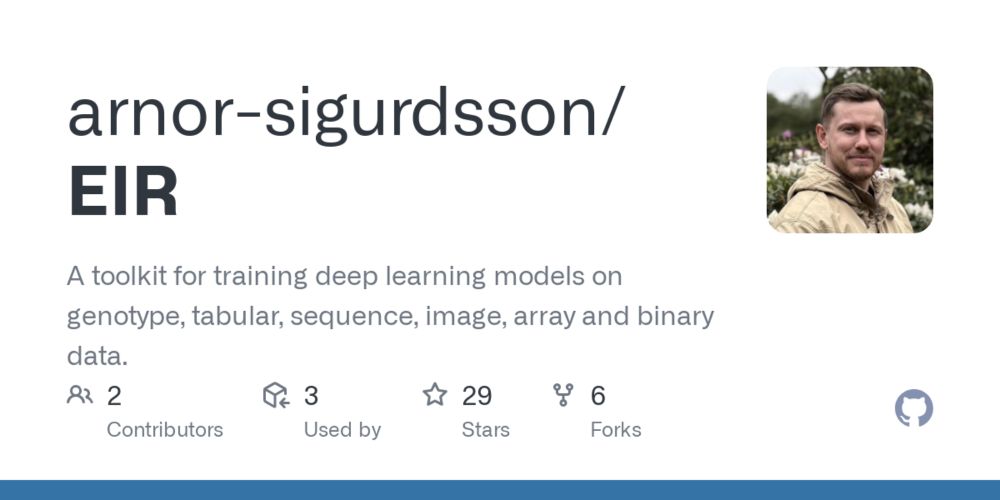
Built by Arnor Sigurdsson from the group, EIR makes large-scale health modeling easier and more powerful.
📦 github.com/arnor-sigurd...
📖 eir.readthedocs.io/en/stable/
@simorasmu.bsky.social

Built by Arnor Sigurdsson from the group, EIR makes large-scale health modeling easier and more powerful.
📦 github.com/arnor-sigurd...
📖 eir.readthedocs.io/en/stable/

🚨 Exciting news! Our EIR framework for modeling multi-modal biomedical data is featured in the first blog post from the new PyTorch Ecosystem WG!
pytorch.org/blog/introdu...
#AI #EHR #Genomics #PyTorch #OpenSource #EIR
24/
And much more, have a look at the paper and thanks to all contributors and co-authors!
23/
In summary:
✅ CCR5delta32 arose once, >6,700 years ago
✅ It spread via Bronze Age demographic expansions
✅ Underwent strong positive selection
✅ Is now a globally relevant variant in medicine
All from an ancient immunogenetic adaptation.
22/
Our spatiotemporal model estimates a rapid westward diffusion of CCR5delta32, covering 60–100 km² per generation.
Its spread likely paralleled the expansion of Steppe-related ancestry into Europe in the Early Bronze Age.
21/
Only Haplotype A (with CCR5delta32) was under positive selection.
This suggests the deletion conferred an adaptive advantage—possibly by modulating immune tolerance in denser Neolithic populations.
20/
Its frequency rose rapidly during the Late Neolithic and Bronze Age — then plateaued.
Strong positive selection from 8,000-2,000 years BP, particular Eastern and Caucasus Hunter Gatherers
19/
Applying HAPI to 934 ancient genomes revealed we identified CCR5delta32
CCR5Δ32 originated once in the Western Steppe ~6,700–9,000 years ago.
18/
Importantly, we benchmarked HAPI against GATK and vg graph-genomes:
✅ HAPI called 63% more ancient genomes
✅ Maintained high precision even at 0.3× coverage
👉 This enables robust indel detection in challenging aDNA datasets.
17/
We used this information to develop HAPI: Haplotype Aware Probabilistic modeling of Indels
Use entire haplotype information to call deletion in ancient samples
16/
Bonus technical details:
We found that CCR5delta32 sits on a specific haplotype — “Haplotype A” — comprising 86 tightly linked variants.
We identify two ancestral haplotypes (B and C) that were widespread long before CCR5delta32 emerged on the haplotype B.
15/
Thanks for reading!
Paper (open access): doi.org/10.1016/j.ce...
Lead authors: Kirstine Ravn, Leonardo Cobuccio, Rasa Muktupavela, Evan Irving-Pease
Affiliations: University of Copenhagen,
14/
So if you’re one of the millions of Europeans who carry this variant—
You share a direct genetic link to a single ancient human whose mutation reshaped immune defenses across Europe.
13/
HIV appeared in the 20th century.
That a Neolithic mutation offers protection against a modern virus is a testament to evolution’s strange, serendipitous logic.
12/
Think of allergic reactions or COVID-19:
It’s often not the virus, but the immune system overreacting, that causes the most damage.
CCR5delta32 may have helped tune immune balance in a world where infections were more common.
11/
Here’s the wild part:
A mutation that damages an immune gene sounds bad.
But in the context of evolving human societies, it might’ve been a life-saving adaptation.
10/
After year 0, we no longer see signs of a positive selection.
But by then, the variant was well established in Northern Europe—and it remains there today.
9/
The spread wasn’t random - it was under positive selection.
This means that early carriers survived better, potentially because the mutation reduced immune responses. This could’ve helped people face new pathogens after the rise of agriculture and dense human settlements.
8/
The variant sits on a large block of DNA that is inherited together - a haplotype.
This includes four other immune genes and their specific genetic variants.
7/
We discovered that the variant arose just once, between 6,700–9,000 years ago—
In a single person on the Eurasian Steppe.
The variant sits on a large block of DNA that is inherited together - a haplotype.
This includes four other immune genes and their specific genetic variants.
6/
To find out, we:
🧬 Analyzed over 2,500 modern human genomes
🦴 Developed a new method to detect CCR5delta32 in ancient DNA
💀 Screened over 900 human skeletons dating back to the Stone Age and Viking era
5/
For instance, in Denmark this would be:
1.0 million people who carry the variant
50,000 people who are resistant to HIV!
Why? Where did it come from?
4/
What’s less known?
In Northern Europe the CCR5delta32 variant is surprisingly common:
🧬 15–25% carries the CCR5delta32 variant
🧬 1-2% are resistant to HIV
3/
This variant isn’t just scientifically interesting.
It made global headlines in 2018 when a Chinese scientist used gene-editing in two embryos to replicate the protective effects of the deletion against HIV.This led to the birth of the so-called CRISPR babies, and to global ethical outcry
2/
The CCR5delta32 variant is a small deletion—32 DNA bases missing from the CCR5 gene.
This “breaks” the CCR5 receptor, which is normally used by HIV to infect human cells.
People who inherit this variant from both parents are highly resistant to HIV.
1/
Out now in Cell: Our new study uncovers the ancient origins of a genetic mutation that protects against HIV — and rewrites the story of its surprising high frequency in Europe.
Link: doi.org/10.1016/j.ce...
Let’s dig in (popular science first, jump to 16 for technical details)
If you haven't already signed up for the #Genomic Mechanism of Disease conference in Copenhagen May 19th - 23rd please consider! Deadline March 15th!
Amazing lineup of speakers and as always incredible venue, organisation and food.
sciencecluster.dk/event/genomi...